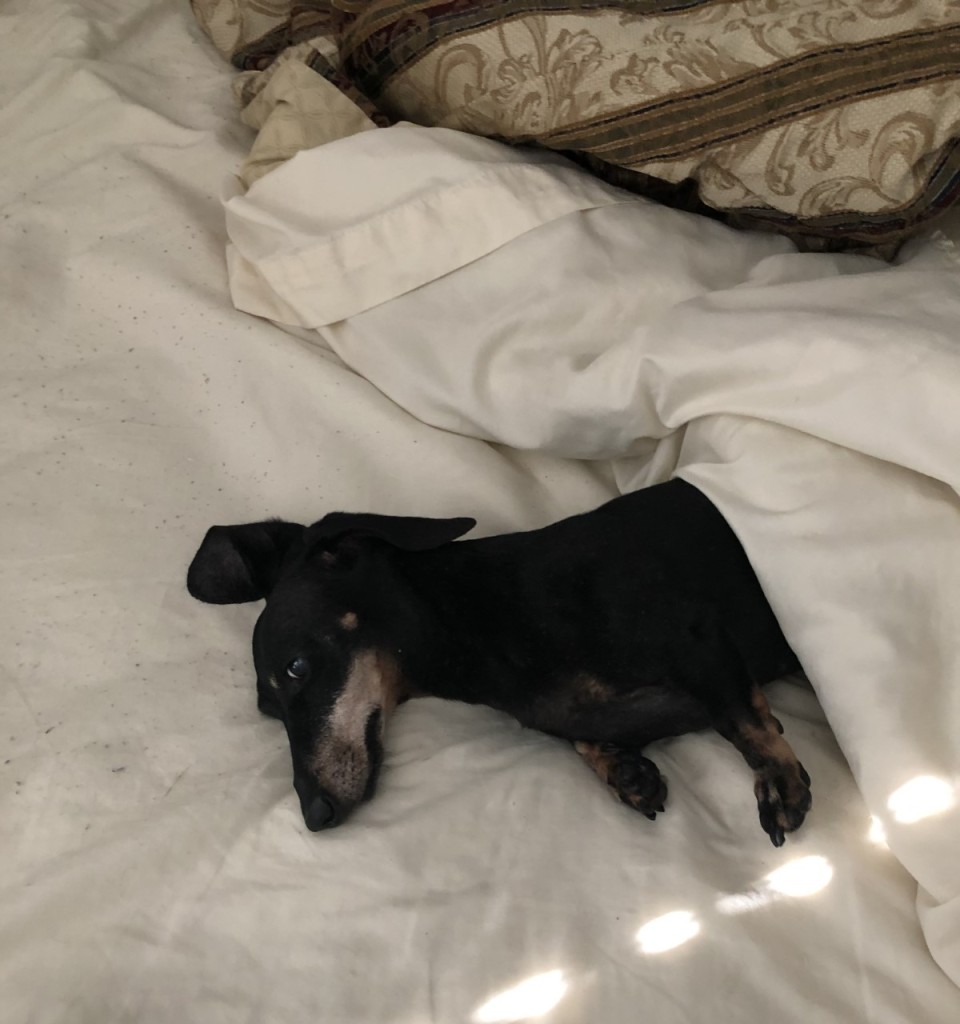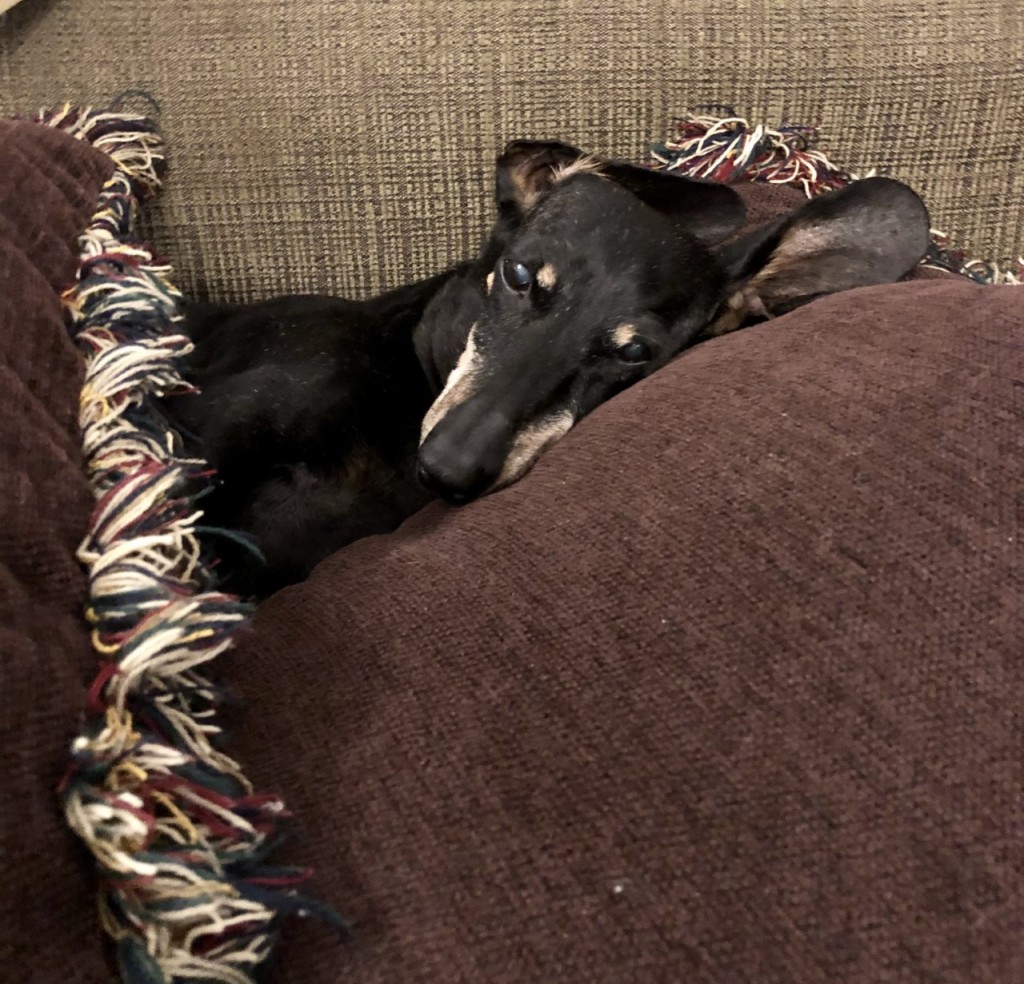
I first saw Buddy at 613 Flagstone in Ft. Oglethorpe at Ray Brown’s (Sean’s dad) house early 2006. He had been neglected, a rescue dog, and brought to Sean’s office to go to Ray’s house. He didn’t even have a name. You could also tell that children had annoyed him and/or abused him. There were neither scars nor broken bones on this thin, handsome miniature black and tan dachshund with a wounded soul. Sean said he was timid and covered with mud when he was brought to the office. Sean gave him a bath, made sure he had plenty to eat, then transported Buddy to Ft. Oglethorpe to be with Ray.
The evening I first saw Buddy he was already spoiled. Buddy had already been eating people food (fried chicken, bacon, cubed steak, whatever Ray had fixed for himself that he shared with Buddy), tried to sleep in Ray’s huge, king-sized bed but didn’t know quite what to do since he had slept outside probably on a chain for a year, but Buddy already felt LOVED. Buddy would not stop springing up to our knees showing his delight for whatever kindness we showed him. It was dark that evening, but I took him for a walk around Ray’s neighborhood. Ray was using an oxygen tank 24/7, and it was difficult for him take Buddy out frequently. Oh, yes, Buddy… he didn’t have his name yet. From the time I met Ray late 2003, his #1 nickname for Sean was “Buddy”. After Buddy had been with Ray for a few days, Sean mentioned to his dad that “Buddy” would be an easy name for Ray to remember. Ray loved the idea, and it didn’t take long for our intelligent little dachshund to recognize his name.
In the beginning, Buddy was a HORRIBLE car rider. In May of 2006, I took him to be neutered. He was all over the vehicle whining. He would even place his front paws up on the steering wheel and peer over it. He looked like he was driving, and to any passer-by up high enough along side of me to see into my truck they could see Buddy “driving”. He also jumped down into the floor board near my feet several times while I was driving. He made me a nervous wreck! Thanks be to God, by the autumn of 2021, he was calm, cool, and collected as he rode in a vehicle.
The last week of January 2007 Ray had to be admitted to Memorial Hospital. After visiting Ray on his admission evening, I drove past Ray’s house to pick up Buddy and Murphy ( a rescue cat) to bring them to our house until Ray was better. Sophie our female dachshund who was our “baby” until Ammon and Carter came along was a bit jealous of Buddy, but not too bad. The worst part of having her guest was sharing her food. Her food was off limits, but her love and care towards Buddy had NO LIMITS. Buddy was totally confused and afraid of using the stairs. As I mentioned in our tribute to Sophie when she passed in 2018, she taught Buddy how to use the stairs. It was a marvel that I will never forget as long as I have a memory. She taught him to take his time and conquer one stair at a time until he was down to the first floor. Several days later, he could go both up and down the stairs. On January 27, 2007, Buddy became our permanent fur child when Ray passed. The rest for us was nearly 15 years of Buddy joy. He was our “Buddy-Buddy boy who gave us Buddy-Buddy joy”.



Buddy was so faithful to Sophie, Sean, Ammon, Carter, and to me. He didn’t know he was a miniature anything. Except for squirrel or his favorite, rabbit tangents, he would walk/jog with us for an hour. After his diversion off the jogging track in and around the barn or through some thicket of trees or shrubs, he would be right back near our feet trotting at our jogging pace. While he was healthy, he only took one jogging break after the neighbor’s dog bit him on his back. He was out of commission for about 2 weeks, but soon he was right back to the jogging. Both Buddy and Sophie LOVED running up on Grindstone Mountain with me and the coonhounds which we did on a regular basis until Carter and Ammon were born the autumn of 2008. It was Sophie’s last trip up on Grindstone December 30, 2017 that we noticed that both Buddy’s agility and eye sight were waning. He misjudged a leap across a boulder and fell in a crevice that was perhaps 8 inches deep. He was by no means harmed. It was well-padded with fallen leaves. We scooped him out quickly. We also noticed that he had trouble on the house steps that went from wood steps to carpet steps. Something about his clouding cataracts caused trouble in the visual transition. By the end of 2020, we started carrying Buddy up and the down the stairs because he kept trying to judge the stairs, misjudged them, then tumbled backwards to kitchen floor.
He had several bouts of health problems from back pain (hereditary dachshund back ailments as well as where the neighbor dog bit him), teeth problems, and finally congestive heart failure! We thought we were going to lose him on April 25 of 2021. He was diagnosed with congestive heart failure, but all the symptoms were looking like pneumonia. The vet at the emergency room clinic wanted to put him down. We said, “In the name of treating a 16 years old dachshund with mercy, please treat him for pneumonia with a powerful antibiotic, and if he lives through the night at his house, then he will die where he is loved.” She complied and we brought him home. He did make it through the night, and he lived for another 6 months!
The first week of November, Buddy made it through a seizure that Sean saw as remarkable. The next morning after the seizure, Buddy acted fairly normal and ate quite a bit of baked chicken. However, it quickly went downhill that evening and the next day. When the vet told us Buddy had kidney failure just a few days after his seizure, we really thought he would rally and make it through the New Year. We had seen Buddy rally so many times. We weren’t fools. We knew that day would come when he wouldn’t “bounce back”. That day came on Tuesday morning November 9, 2021. Sean had been Buddy’s constant nurse maid for almost a week. Sean was with his “Buddy” (remember Buddy was Ray’s endearing name for Sean for decades) until Buddy took his last dog breath and crossed into dog eternity. We know Sophie was waiting for her brother and Ray was reunited with his fur baby, “Buddy”. The three are all enjoying heaven together as I type this.
Thank you, God , for our fur babies and our fur “buddies” especially our Buddy-Buddy Boy.






























